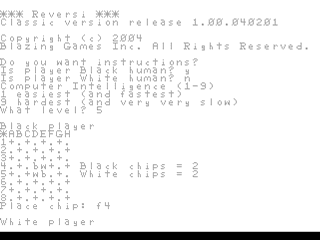

This game uses plug-ins and will be depreciated. To prevent vote spamming, votes are tracked by IP addresses so by clicking on vote you agree to allow me to store your IP address in association with your vote.
For more information about the site shutdown, click here. To see the current standings of games (in order of popular vote) click here.
Note that all episodes of this series are grouped together so voting forone is the same as voting for all episoded.
![]() Blazing Games - Ultimate Retro Project - Volume 3 - Episode 33
Blazing Games - Ultimate Retro Project - Volume 3 - Episode 33
Ultimate Retro Project
Episode 33: Classic Reversi

Essentially, a simplified version of Go.
Page Last Updated: April 1, 2006
Introduction
This strategy game is a simplified variation of the ancient game of go. The game uses a game board the same size as a checkers or chess board except traditionally the board does not have a checkers pattern (though I have played the game on a checkers board and don’t see what the big deal is. I guess purists just like to hear the sound of their own voices).
Using the Console
Creating text games is interesting, but my goal was also to present the game in a way that would simulate a teletype machine as close as possible. This is why the game uses my console.
My Teletype Emulator is designed to simulate playing the game on an old teletype machine, down to the dot matrix output. Anybody who has used an old printer knows how slow they were. They were also noisy, but out of the goodness of my heart, I decided to leave the noise out.
For getting input from the user, I decided to go with a fancy LCD model, in which what you type will be send to a LCD display for your approval before being transmitted to the machine. Unlike real machines, my terminal is intelligent and will only let you enter something when the program is requesting input. Any other typing is ignored!
Playing the Game
The game starts out with two black chips and two white chips in alternating positions in the center of the board. On each turn players add a chip of their color to the board. The rules for adding a chip are fairly simple. The chip must be placed next to an opposite colored chip where there is a same colored chip in line horizontally, vertically, or diagonally. At this point all the opponents chips that are between the placed chip and a same colored chip horizontally, vertically or diagonally from the placed chip become that player’s color.
If the player is not able to place a chip that will capture opponent chips, they must skip their turn. The game ends when neither player is able to make a move - usually when all 64 locations have been filled but sometimes earlier. The player with the most chips of their color wins!
Entering coordinates
Making a move is simply a matter of specifying the coordinates of the piece you want to move followed by the location of where you want to move to. Coordinates are entered as a letter number pair. For example, H8 or A1. For jumps, specify the coordinate the piece will be in after the jump has been completed. For multiple jumps, specify the coordinates of the first jump, you will then be prompted for additional jumps.
System Requirements
This game is requires Java 1.1 or better to run. Browsers that support 1.1 tend to be 4.x or better versions. Windows XP users may have to download a Java plug in to use Java applets.
Clicking on the link below indicates that you agree to the disclaimer (click here to read).
PLAY Classic Reversi
Please note that the above links open in a new window. Popup blocking software may not allow this so read the popup blocker's instructions for allowing this (unless you are also running ad blocking software, in which case please don't play the game as it costs money [made by the advertising] to keep this site running).
Back to Ultimate Retro Project volume 3 Index
About -
Privacy Policy -
Contact -
Links -
FAQ
Copyright © 2004-2006 Blazing Games Inc. All Rights Reserved.
